NALANDA

Xuanzang Memorial Hall in Nalanda
Nalanda (80 kilometers south-southeast of Patna) contains the ruins of famous university that helped spread Buddhism throughout Asia. Among it students were Xuanzang, the famous 7th-century Chinese scholar and traveler, who helped introduce Buddhism to China. Nalanda is a small town. The ruins comprise Nalanda University, 11 monasteries and six brick temples and remains of structures from the Mauryan and the Gupta dynasties. Xuanzang mentioned that the city was named after a serpent. It is said that Sariputra, an ardent follower of Lord Buddha, was also here.
The Archaeological Site of Nalanda Mahavihara at Nalanda was named a UNESCO World Heritage Site in 2016. According to UNESCO World Heritage website: It comprises the archaeological remains of a monastic and scholastic institution dating from the 3rd century B.C. to A.D. the 13th century. It includes stupas, shrines, viharas (residential and educational buildings) and important art works in stucco, stone and metal. Nalanda stands out as the most ancient university of the Indian Subcontinent. It engaged in the organized transmission of knowledge over an uninterrupted period of 800 years. The historical development of the site testifies to the development of Buddhism into a religion and the flourishing of monastic and educational traditions. [Source: UNESCO]
Jeffrey E. Garten, dean of the Yale School of Managment, wrote in the New York Times: “Founded in 427 in northeastern India, not far from what is today the southern border of Nepal, and surviving until 1197, Nalanda was one of the first great universities in recorded history. It was devoted to Buddhist studies, but it also trained students in fine arts, medicine, mathematics, astronomy, politics and the art of war. [Source: Jeffrey E. Garten, New York Times, December 9, 2006 ==]
“The university was an architectural and environmental masterpiece. It had eight separate compounds, 10 temples, meditation halls, classrooms, lakes and parks. It had a nine-story library where monks meticulously copied books and documents so that individual scholars could have their own collections. It had dormitories for students, perhaps a first for an educational institution, housing 10,000 students in the university’s heyday and providing accommodations for 2,000 professors. Nalanda was also the most global university of its time, attracting pupils and scholars from Korea, Japan, China, Tibet, Indonesia, Persia and Turkey. ==
“The university died a slow death about the time that some of the great European universities, including those in Oxford, England, and Bologna, Italy, were just getting started, and more than half a millennium before Harvard or Yale were established. Its demise was a result of waning enthusiasm for Buddhism in India, declining financial support from successive Indian monarchs and corruption among university officials. The final straw was the burning of the buildings by Muslim invaders from what is now Afghanistan.” ==
Getting There: By Air: Patna’s Loknayak Jaiprakash Airport, around 80 kilometers, is the nearest airport that is connected to major Indian cities. By Road: Good roads connect Nalanda with other cities in the state and the country. By Train: The nearest railhead is at Rajgir, around 12 kilometers away, that connects the city with Delhi, Patna and Gaya.
Nalanda University
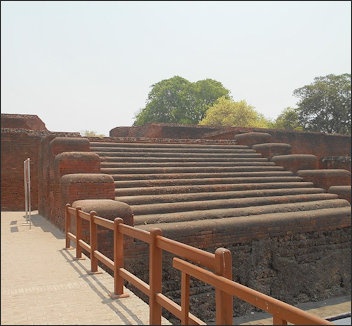
Nalanda University Library
Nalanda University in India is regarded as the world's oldest university by far. Describing by the Xuan Zang's 7th century record of his journey to the West, it flourishing for centuries before it was destroyed by Afghan invaders in the 12th century. For over 700 years, it was a center of learning for a wide range of subjects, including philosophy, science, mathematics and public health. In 2011, the Indian Parliament passed a bill reestablishing Nalanda University as an international university.[Source: George Yeo, Global Viewpoint, April 12, 2011]
According to UNESCO World Heritage website: “Nalanda is one of the most ancient international centers of education and learning equivalent to modern universities, with a very rich library. An inscribed seal written "Sri-Nalandamahavihariy-Arya-Bhikshu-Sanghasya" identifies the site as Nalanda Mahavihara. Nalanda has a very ancient history and goes back to the days of Mahavira and Buddha in sixth and fifth centuries B.C. Many references in the Pâli Buddhist literature mention about Nâlandâ. It is said that in course of his journeys Buddha often halted at this place. It is also the place of birth and nirvana of Sariputra, one of the famous disciples of Buddha. [Source: UNESCO World Heritage website ]
“The place rose into prominence in 5th Century A.D. as a great monastic-cum-educational institution for oriental art and learning in the whole Buddhist world, attracting students from like Hiuen Tsang and I-Tsing from China and other distant countries. The galaxy of luminaries associated with it includes Nagarjuna, Aryadeva, Vasubandhu, Dharmapala, Suvishnu, Asanga, Silabhadra, Dharmakirti, Shantarakshita. Another important mention in history, is that around second century, Suvishnu built one hundred and eight temples at Nalanda to prevent the decline of the Hînayâna and Mahâyâna schools of Buddhism.
“Various subjects like theology, sabda-vidyâ grammar, hetu-vidyâ (logic), astronomy, metaphysics, chikitsâ-vidyâ medicine and philosophy were taught here. The accounts of pilgrim state that Nâlandâ was bustling with literary activities. Nâlandâ had now acquired a celebrity spread all over the east as a centre of Buddhist theology and educational activities. This is evident from the fact that within a short period of thirty years following Hiuen Tsang's departure, no less than eleven Chinese and Korean travelers are known to have visited Nalanda.
“Life lead by Nalanda monks is regarded as the ideal to be followed by the Buddhist all over the world. This celebrity status persisted through ages. It is also attributed that a detailed history of Nalanda would be the history of Mahayanist Buddhism. The institution was maintained by the revenue collected from the villages bestowed specifically for the purpose by the contemporary rulers as evident from inscriptions. Royal patronage was therefore the key note of the prosperity and efficiency of Nâlandâ.
History of Nalanda University
According to the UNESCO World Heritage website: “Nalanda has a very ancient history going back to the days of Mahavira and Buddha 6th Century B.C. According to the Jain text Mahavira spent as many as 14 rainy seasons over there . Nalanda acquired sanctity as having being the birth place of Sariputra one of the disciples of Lord Buddha . Taranath a Buddhist philosopher states that Asoka worshipped at the chaitya of Sariputra and erected a temple here. Taranath also connects Aryadeva with Nalanda. Further Asanga a Buddhist philosopher of great repute (5th Century A.D.) is said to have spent 12 years of his life and was succeeded by his brother Vasubandhaa as the high priest of Nalanda. [Source: UNESCO World Heritage website ]
“Nalanda not only enjoys a special place in the history of Buddhism but also in the history of art, religion, architecture and scriptures as it is a great monastic - cum educational institution for Buddhist art and learning in the whole world and has attracted students from distant countries like China, Korea etc from 5th Century A.D. onwards.
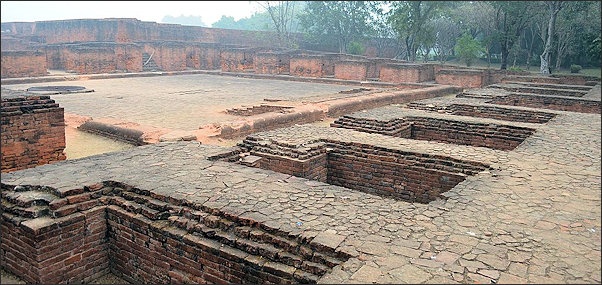
Nalanda University rooms for students
“The real importance of Nalanda began during the Gupta rule in the 5th Century A.D. The monasteries of Nalanda were the creation of the Gupta emperors beginning with Kumaragupta I. Harshavardhana of Kanauj (606-647) also helped the development of the Institution by his munificence. He built a monastery of brass here as has been recorded by the great traveler Hiuen Tsang in his chronicler. As has been recorded by Hiuen Tsang that a long succession of kings continued the work of building using all skills the whole is a marvelous creation. In the time of the Palas, Nalanda rose even to a greater importance. They established other monasteries such as Vikramshila , Somapura, Odantapuri and Jagaddala which must have created a diversion in the activities of the Buddhist scholars. It was during this period that celebrities like Padmasambhava, a great luminary of Nalanda visited Tibet.
“There were many renowned scholars who by their deep learning and excellence of conduct maintained the dignity which Nalanda enjoyed. Early Mahayana philosophers Nagarjuna, Aryaveda Asanga and Vashubandhu were the high priests of Nalanda. Next in point of chronology comes the name of Dinnaga who also received the title "tarka -pungava". Dharmapala Silabhadra, Dharmakriti were some of the famous scholars of Nalanda whose excellence used to attract best students from different corners of the world. The fame of these scholars spread to distant countries and persisted through ages.
“From the record of Ising in 673A.D. we get a detailed picture of the subject studied in Nalanda. His work not only records the minute details about the kind of life he led in Nalanda but also talks about the curriculum which besides the Buddhist scriptures included logic , metaphysics and a very extensive study of Sanskrit grammer. The monks used to follow a strict rule of discipline.
“Towards the close of the 12th Cent. A.D Nalanda fell a prey to the destructive hands of the muslims when Dhramasvamin visited the place in 1235-36 A.D. the establishment was a shadow of the past. The skeleton establishment disappeared shortly but not before14th Century A.D. before he went to Srilanka.As Dhyanabhadra of a Korean inscription who was a native of Magadha is said to have studied in this institution before he went to Sri Lanka.

Nalanda University classrooms
Education at Nalanda University
“Nalanda is one of the most ancient international centers of education and learning equivalent to modern universities, with a very rich library. An inscribed seal written "Sri-Nalandamahavihariy-Arya-Bhikshu-Sanghasya" identifies the site as Nalanda Mahavihara. Nalanda has a very ancient history and goes back to the days of Mahavira and Buddha in sixth and fifth centuries B.C. Many references in the Pâli Buddhist literature mention about Nâlandâ. It is said that in course of his journeys Buddha often halted at this place. It is also the place of birth and nirvana of Sariputra, one of the famous disciples of Buddha. [Source: UNESCO World Heritage website ]
“The place rose into prominence in 5th Century A.D. as a great monastic-cum-educational institution for oriental art and learning in the whole Buddhist world, attracting students from like Hiuen Tsang and I-Tsing from China and other distant countries. The galaxy of luminaries associated with it includes Nagarjuna, Aryadeva, Vasubandhu, Dharmapala, Suvishnu, Asanga, Silabhadra, Dharmakirti, Shantarakshita. Another important mention in history, is that around second century, Suvishnu built one hundred and eight temples at Nalanda to prevent the decline of the Hînayâna and Mahâyâna schools of Buddhism.
“Various subjects like theology, sabda-vidyâ grammar, hetu-vidyâ (logic), astronomy, metaphysics, chikitsâ-vidyâ medicine and philosophy were taught here. The accounts of pilgrim state that Nâlandâ was bustling with literary activities. Nâlandâ had now acquired a celebrity spread all over the east as a center of Buddhist theology and educational activities. This is evident from the fact that within a short period of thirty years following Hiuen Tsang's departure, no less than eleven Chinese and Korean travelers are known to have visited Nalanda.
“Life lead by Nalanda monks is regarded as the ideal to be followed by the Buddhist all over the world. This celebrity status persisted through ages. It is also attributed that a detailed history of Nalanda would be the history of Mahayanist Buddhism. The institution was maintained by the revenue collected from the villages bestowed specifically for the purpose by the contemporary rulers as evident from inscriptions. Royal patronage was therefore the key note of the prosperity and efficiency of Nâlandâ.
Xuanzang
In A.D. 629, early in the Tang Dynasty period, the Chinese monk Xuanzang (Hsuan Tsang) left the Chinese dynasty capital for India to obtain Buddhist texts from which the Chinese could learn more about Buddhism. He traveled west — on foot, on horseback and by camel and elephant — to Central Asia and then south and east to India and returned in A.D. 645 with 700 Buddhist texts from which Chinese deepened their understanding of Buddhism. Xuanzang is remembered as a great scholar for his translations from Sanskrit to Chinese but also for his descriptions of the places he visited — the great Silk Road cities of Kashgar and Samarkand and the great stone Buddhas in Bamiyan, Afghanistan. His trip inspired the Chinese literary classic “Journey to the West” by Wu Ch'eng-en, a 16th century story about a wandering Buddhist monk accompanied by a pig, an immortal that poses as a monkey and a feminine spirit. It is widely regarded as one of the great novels of Chinese literature. [Book: "Ultimate Journey, Retracing the Path of an Ancient Buddhist Monk Who Crossed Asia in Search of Enlightenment" by Richard Bernstein (Alfred A. Knopf); See Separate Article on Xuanzang]
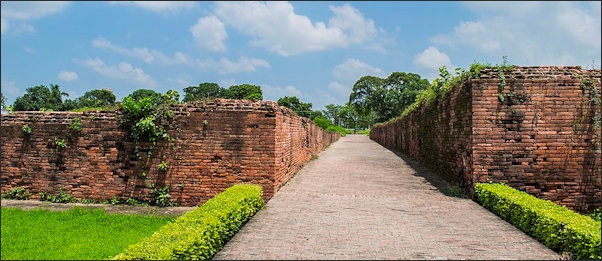
Nalanda University Center of Knowledge
Xuanzang was as philosopher, educator and translator as well as being a monk and traveler. Tansen Sen wrote in Education about Asia: “ Xuanzang was a leading Indophile of ancient China. The Chinese monk not only promoted Buddhist doctrines and the perception of India as a holy land through his writings, he also tried to foster diplomatic exchanges between India and China by lobbying his leading patrons, the Tang rulers Taizong (reigned 626–49) and Gaozong (reigned 649–683). In fact, the narrative of his pilgrimage to India, The Records of the Western Regions Visited During the Great Tang Dynasty, was meant for his royal patrons as much as it addressed the contemporary Chinese clergy. Thus, Xuanzang's work is significant both as an account of religious pilgrimage and as a historical record of foreign states and societies neighboring Tang China. In fact, in the work Xuanzang comes across both as a pious pilgrim and as a diplomat for Tang China." [Source: Tansen Sen, Education about Asia, Volume 11, Number 3 Winter 2006]
According to Silk Road Seattle: Xuanzang was a Chinese Buddhist monk and translator who traveled across the Tarim basin via the northern route, Turfan, Kucha, Tashkent, Samarkand, Bactria, then over the Hindu Kush to India. He departed the Tang capitol (Chang'an) in 629 and returned via the southern route in 645. The remainder of his life was spent translating into Chinese the sutras which he had collected in India. At the request of the Tang Emperor Taizong (r.626-649) he composed a description of the lands through which he traveled. After his death, his travels and story became fantastic legends which were used in plays and novels."Source: Silk Road Seattle, depts.washington.edu/silkroad ]
See Separate Article XUANZANG: THE GREAT CHINESE EXPLORER-MONK factsanddetails.com ; XUANZANG IN WESTERN CHINA factsanddetails.com ; XUANZANG IN CENTRAL ASIA factsanddetails.com ; XUANZANG IN AFGHANISTAN factsanddetails.com ; XUANZANG IN INDIA (630-645) factsanddetails.com
Xuanzang at Nalanda
Der Huey Lee of Peking University wrote:“At long last, Xuanzang reached his ultimate destination, where his strongest personal interest in Buddhism was located and the principal portion of his time abroad was spent: the Nalanda monastery, located southwest of the modern city of Bihar in northern Bihar state. As a far-famed metropolis of Buddhist monastic education, Nalanda was a veritable monastic city consisting of some ten huge temples with spaces between divided into eight compounds, surrounded by a high wall. There were over ten thousand Mahayana monks there engaged in the study of the orthodox Buddhist canon as well as the Vedas, arithmetic, and medicine. According to legend, Silabhadra (529-645), abbot of Nalanda, was considering suicide after years of wasting illness when he received instructions from deities in a dream, commanding him to endure and await the arrival of a Chinese monk in order to guarantee the preservation of the Mahayana tradition abroad. [Source: Der Huey Lee, Peking University, China Internet Encyclopedia of Philosophy iep.utm.edu/xuanzang ^^]
Sally Hovey Wriggins wrote: “ Xuanzang had been traveling in northern India for 5 years before he finally arrived at Nalanda, the most famous monastery- university in India in 637 CE. Monks from all over Asia attended lectures on grammar, logic, Buddhist philosophy, Sanskrit, medicine, mathematics, astronomy, literature, and works of magic. Xuanzang remained here for a total of 2 years, returning for a final visit in 642 CE."xvi] He was also particularly interested in the lectures on Yogachara Buddhism, the mystic philosophy that had drawn him to India in the first place. As he was a special guest from far away, he was given the use of a palanquin or an elephant for trips outside Nalanda to visit famous sites of the Buddha where he preached at Vulture Peak and the Buddha's miracle at Rajagriha. [Source: “Xuanzang on the Silk Road” by Sally Hovey Wriggins mongolianculture.com \~/]
Xuanzang Studies at Nalanda
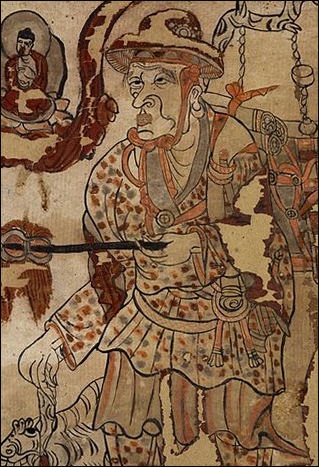
Xuanzang
Der Huey Lee of Peking University wrote: “Xuanzang became Silabhadra's disciple in 636 and was initiated into the Yogacara lineage of Mahayana learning by the venerable abbot. While at Nalanda, Xuanzang also studied Sanskrit and Brahmana philosophy. Subsequent studies in India included hetu-vidya (logic), the exegesis of Mahayana texts such as the Mahayana-sutralamkara (Treatise on the Scripture of Adorning the Great Vehicle), and Madhyamika ("Middle-ist") doctrines. [Source: Der Huey Lee, Peking University, China Internet Encyclopedia of Philosophy iep.utm.edu/xuanzang ^^]
“The name of the Madhyamika School, founded by Nagarjuna (2nd century CE), derives from its having sought a middle position between the realism of the Sarvastivada (Doctrine That All Is Real) School and the idealism of the Yogacara (Mind Only) School. Xuanzang appears to have combined these two systems into each other in a more eclectic and comprehensive Mahayanism. With the approval of his Nalanda mentors, Xuanzang composed a treatise, Hui zong lun (Hui-tsüng-lun or On the Harmony of the Principles), which articulates his synthesis. ^^
“At Nalanda, Xuanzang became a critic of two major philosophical systems of Hinduism opposed to Buddhism: the Samkhya and the Vaiseshika. The former was based upon a dualism of Nature and Spirit. The latter was a realist system, immediate and direct in its realism, resting upon the acceptance of the data of consciousness and experience as such: in brief, it was a melding of monism and atomism. Such beliefs were in absolute contradiction to the acosmic idealism of the Buddhist Yogacara, which evenly repelled the substantial entity of the ego and the objective existence of matter. Xuanzang also critiqued the atheistic monism of the Jains, especially inveighing against what he saw as their caricature of Buddhism in terms of Jain monastic garb and iconography. ^^
“Xuanzang's success in religious and philosophical disputes evidently aroused the attention of some Indian potentates, including the King of Assam and the poet-cum-dramatist king Harsha (r. 606-647), who was regarded as a Buddhist patron saint upon the throne like Ashoka and Kanishka of old. An eighteen-day religious assembly was convoked in Harsha's capital of Kanauj during the first week of the year 643, during which Xuanzang allegedly defeated five hundred Brahmins, Jains, and heterodox Buddhists in spirited debate. ^^
Nalanda Ruins
The ruins of Nalanda are fun to explore and surrounded by nicely-kept gardens and lawns. Walking through what once used to be one of the world's first residential universities, is a fascinating experience. Although the ruins consist primarily of brick walls it easy to make out what was what and figure out how they all fit together. Built by the Gupta emperors starting in A.D. 450, the university complex could house 10,000 students and 2000 teachers.
The university complex was home to different compounds, student dormitories, meditation halls, temples and a library. The dormitories still house remains like stone beds, study tables and ancient ink pots. The basement of the dormitory houses the kitchen. Archaeological findings revealed that the place must have been the kitchen since burnt rice was found in the basement. The grains of rice are displayed at the Nalanda Museum, along with the other items discovered during the excavations. As you walk further, winding stairs will lead you to a long corridor with rooms on either side. These must have been the classrooms for students and are the only portion of the university ruins, which still have their roof intact.
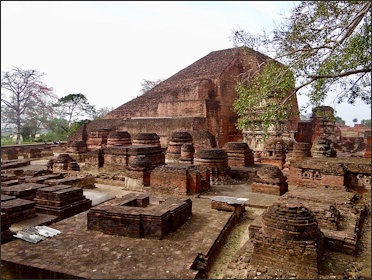
Nalanda University mounds and ruins
The red brick ruins that also include 11 monasteries and six temples situated on either side of a wide passage. The monasteries in Nalanda have been built in the Kushan style of architecture and most structures suggest that new buildings were raised atop the ruins of the old ones, which shows that the university underwent through multiple periods of construction. The most iconic of all these ruins is the Great Stupa, also known as the Nalanda Stupa or the Sariputra Stupa. Built in the 3rd century by Mauryan emperor Ashoka, in the honour of Buddha's follower Sariputra, the stupa is shaped like a pyramid at the top. The multiple flights of stairs surrounding the stupa, lead all the way to its top. Beautiful sculptures and votive stupas flank the structure. These votive stupas have been built with bricks and passages from sacred Buddhist texts have been inscribed on them. It is believed that these stupas were constructed over the ashes of Lord Buddha. Archaeological evidence suggests that the stupa was originally a small structure and was later enlarged by further construction.
Nalanda Stupa , also known as the Sariputra Stupa, is one of the most important surviving monuments in Nalanda. Built in the A.D. 3rd century by Mauryan emperor Ashoka, in the honour of Buddha's follower Sariputra, the great Nalanda Stupa is shaped like a pyramid at the top. The multiple flights of stairs surrounding the stupa, lead all the way to its top. Beautiful sculptures and votive stupas flank the structure. These votive stupas have been built with bricks and passages from sacred Buddhist texts have been inscribed on them. It is believed that these stupas were constructed over the ashes of Lord Buddha. The most striking of all the votive stupas is the fifth one, which has been preserved well along with its corner towers. These towers are adorned with exquisite panels of Gupta-era art that include stucco figures of Lord Buddha and scenes from the Jataka tales. The top portion of the stupa features a shrine chamber that houses a pedestal, which must have been originally used to place a large Lord Buddha statue. The Gwe Bin Tet Kon stupa in Myanmar is said to be influenced by the Nalanda Stupa.
Nalanda Sights
Nalanda's Archaeological Museum houses thousands of antiquities. The museum was established in 1917 and prides itself as being one of Rajgir's earliest university-cum monastery complexes. The main attraction of the museum are the well-preserved statues of Lord Buddha, along with a beautiful collection of Buddhist and Hindu bronze items. The museum also has two enormous terracotta jars that date back to the first century. Tourists can also find displays of copper plates, stone inscriptions, coins, pottery and other antiquarian objects. The museum has four galleries that display around 349 antiquities dating back to 5th-12th century. The first gallery showcases 57 sculptures and images while the second gallery presents miscellaneous objects like stuccos, terracotta products and iron implements. The third gallery is entirely dedicated to bronze items and the last gallery displays stone images and sculptures. The museum is a must-visit place for lovers of art and history.
Surajpur Baragaon (northern Nalanda, near Nalanda University) is the home of a lake and a temple dedicated to the sun god, Lord Surya. It is one of the most ancient and popular attractions of Nalanda. The temple houses a number of statues of Hindu and Buddhist deities. The main attraction among these statues is the one dedicated to Goddess Parvati, which stands at a height of 5 feet.Surajpur Baragaon is visited by a large number of pilgrims during the chhat puja in the Hindu calendar months of Baisakha and Kartik.. According to popular belief, anyone who enters the temple will never return empty handed from the temple.
Hieun Tsang Memorial Hall was built in the memory of Hiuen Tsang (Xuanzang), the traveler who had come to study Buddhism and mysticism at the Nalanda University in A.D. 633, and stayed here for 12 years. Tsang travelled around the country and also visited Takshila for further studies on Buddhism. The place where he used to learn yoga from his teacher Acharya Shil Bhadra, is now known as the memorial hall. The construction of the hall was started in January 1957 by Pt Jawaharlal Nehru and got completed in 1984. During his stay, Tsang collected a number of documents that are a major source of history in Buddhist writing. These are well preserved in the memorial hall.
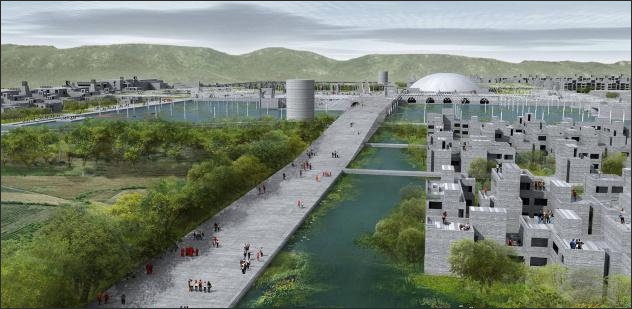
Proposed new University of Nalanda campus
Nava Nalanda Mahavira is a relatively new institute dedicated to the study and research of Pali literature and Buddhism. It invites students from foreign countries as well. The institute was founded with an aim to develop it as a center of higher studies in Pali and Buddhism along the lines of ancient Nalanda Mahavihara. The institute has been functioning as a residential institution ever since it was started and offers a limited number of seats to Indian and foreign students. The Nava Nalanda Mahavihara has been accorded the status of a “Deemed to be University” by the University Grants Commission of India. The present campus of the Mahavihara is situated on the southern bank of the historical Indrapuskarani Lake, while the ruins of the ancient Nalanda University lie close to the northern bank of the lake.
Kundalpur (on the outskirts of Nalanda) is one of the most important pilgrim centers of Jainism. It is considered to be the birthplace of Lord Mahavira, the founder of Jainism and the final tirthankar (saint). To mark the place, a four-and-a-half-foot-tall Lord Mahavira idol has been placed in a temple here. In the same complex is Trikal Chaubeesi Jain Mandir that houses 72 idols of tirthankars. Each of these represents 24 saints, each of the past, present and future. Near the temple complex are two lakes known as Dirga Pushkarni and Pandava Pushkarni. Kundalpur is also known for the Nandyavarta Mahal, a seven-storeyed building which is said to be the birthplace of Lord Mahavira. A marvellous structure once, the palace now lies in ruins.
Rebuilding Nalanda University
In September 2013, a proposal was approved by the Indian government to rebuild Nalanda University. AFP reported: “Indian academics have long dreamt of resurrecting Nalanda University. Now the chance of intellectual life returning to Nalanda has come one step closer after the parliament in New Delhi passed a bill approving plans to re-build the campus as a symbol of Indias global ambitions. It has been estimated that 500 million dollars will be required to build the new campus, with a further 500 million to improve the surrounding infrastructure in what is one of Indias poorest regions. [Source: AFP, September 13, 2010 +++]
“The new Nalanda University has been allocated 500 acres (200 hectares) of land near its original location, but supporters who have lobbied for the cause for several years admit that major funds are needed if Nalanda is to rise from the ashes. “Income from a number of villages, and funds from kings, supported the ancient Nalanda. Now we have to look for donations from governments, private individuals and religious groups,” the renowned economist and Nobel laureate Amartya Sen said. +++
“Nalandas backers believe it could help reverse the tide so that one day foreign students compete to attend Indian universities. “The idea of setting up Nalanda again is brilliant but we need to understand the real essence of Nalanda. It embodied universality,” said Phagun Pathak, a educationalist based in Delhi. “Nalanda should be Indias chance to open doors to international faculties and students,” he told AFP. Among those on the board of the Nalanda Mentor Group is Singapores Foreign Minister George Yeo, who has said Buddhist groups in the wealthy city-state have shown interest in raising funds. Other Buddhist groups in Japan and supporters in China are also being targeted for financial support. +++
“For intellectuals, any new university bearing the Nalanda name will have a lot to live up to. “In the history of universities and learning, Nalandas name is sacred and its end was a tragic episode,” said Ravikant Singh, a professor of history in a private college in Bihar. “Everything was burnt down but its illustrious legacy has remained forever.” Other academics say the plans for Nalanda look to the future as much as to the past. “Engaging with our neighbours through education and culture is the right way forward,” said Chitra Sengupta, an international relation analyst at the Delhi University.” +++
Image Sources: Wikimedia Commons
Text Sources: India tourism website (incredibleindia.org), India’s Ministry of Tourism and other government websites, UNESCO, Wikipedia, Lonely Planet guides, New York Times, Washington Post, Los Angeles Times, National Geographic, The New Yorker, Bloomberg, Reuters, Associated Press, AFP, Yomiuri Shimbun and various books and other publications.
Updated in January 2024
